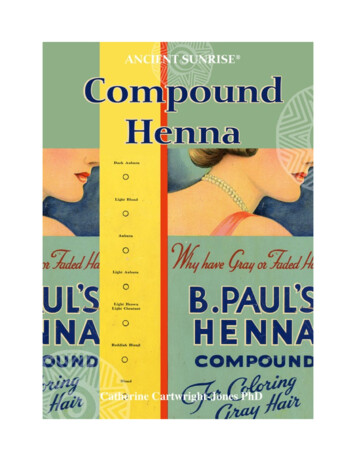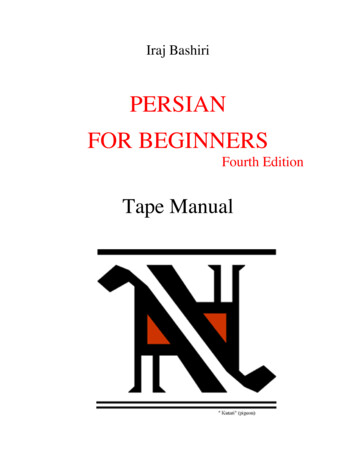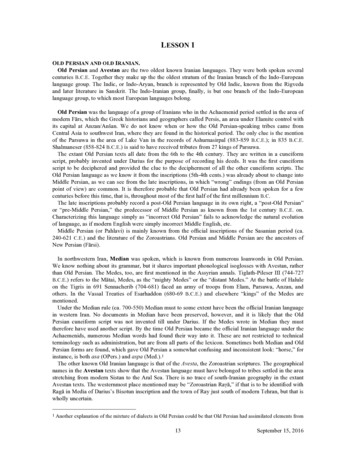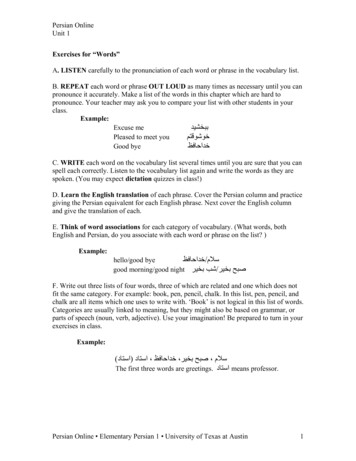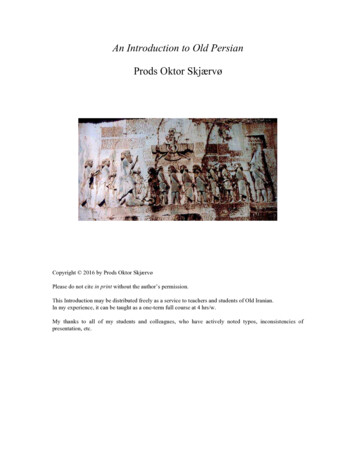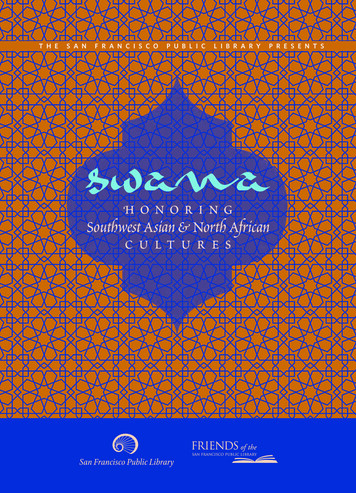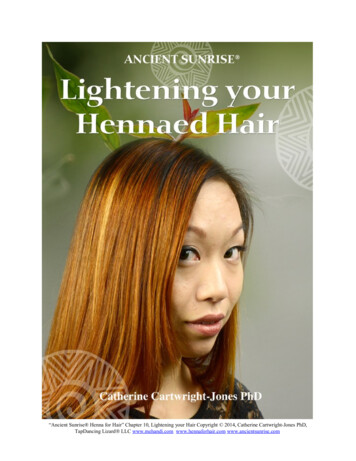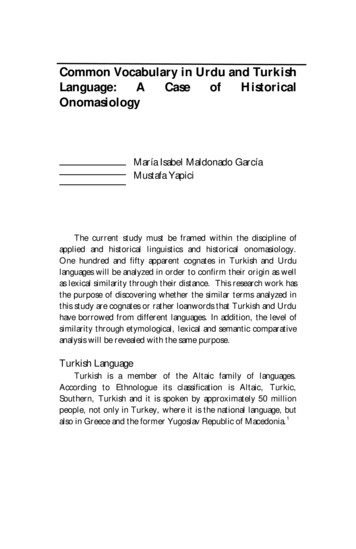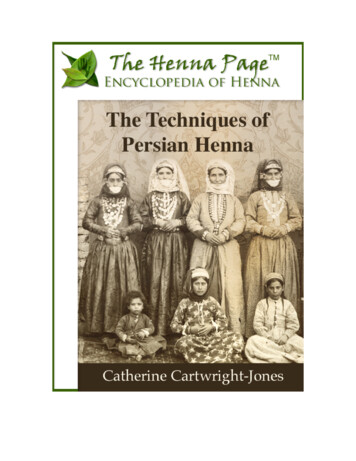
Transcription
2The Techniques of Persian HennaCatherine Cartwright-JonesI would like to thank the John Rylands Library in Manchester, the Bodleian Library inOxford, the British Library in London, and the Victoria and Albert Museum in Londonfor permitting me to view original Persian manuscripts and works of art in person. Thisis a rare privilege and I am very grateful to have had this opportunity.I would also like to thank the Iranian Heritage Society for providing assistance andfunding for this research.In this paper, I propose to demonstrate that women’s hand and foot markings in pictorialand literary Persian art between the late 15th century and the mid 19th are representationsof henna body art, and that this interpretation of the markings is corroborated by Persianliterature and traveler’s descriptions. I propose that the representations are idealized butplausible representations of henna, and they demonstrate the technical processes andsocial uses of henna art in Persia. These depictions can also be read for class, gender, andthe evolving Persian concept of ideal women’s beauty into the period of increasedEuropean influence on style in the Qajar dynasty.I have supplied images and experience from my own work as a henna artist to support myinterpretations of henna technique and stain, and offer them as an approach toreconstructing old techniques.The works featured in this investigation are: “Shirin Examines Khusraws Portrait”, late 15th century Iran, plate 2, Khamsa ofNizami, Arthur Sackler Gallery, Smithsonian Institution, s1986.140This paper was originally written in partial fulfillment of the requirements for a PhD dissertation in the Geography Department at KentState University as ARTH-62098RESEARCH1 10983 005 and 17257 006 by Catherine Cartwright-Jones, 2009
3 “Bilqis visiting Solomon”, about 1530 CE, Iran, from Assembly of LoversBodleian Library Oxford MS Ouseley ADD 24 Folio 1270 “A Nomadic Encampment”, (1539 – 43, Iran), folio from a manuscript of theKhamsa (Quintet) of Nizami, attributed to Mir Sayyid ‘Ali, Arthur M. SacklerMuseum, Harvard University Art Museum 1958.75 “Nighttime in a Palace”, (1539 – 43 Iran), folio from a manuscript, attributed toMir Sayyid ‘Ali, Arthur M. Sackler Museum, Harvard University Art Museum1958.76This paper was originally written in partial fulfillment of the requirements for a PhD dissertation in the Geography Department at KentState University as ARTH-62098RESEARCH1 10983 005 and 17257 006 by Catherine Cartwright-Jones, 2009
4 “Two Harem Girls”, attributed to Mirza Baba, Iran 1811-14, Collection of theRoyal Asiatic Society London, 01.002 “Ladies around a Samovar” Tehran, third quarter of the 19th century. Victoria andAlbert Museum, P. 6-1941Note:In this paper, I use “Persia” or “Persian” and “Iran” or “Iranian”. For the purpose of thispaper, I use “Persia” to refer to a region ruled by one of the Persian empires. I use“Persian” to refer to the dominant culture of the Persian empires, as opposed to Kurdish,or Turkic, which also existed in the region of “Persia”. I use “Iran” to refer to the regiondefined by the political boundaries of the modern Iranian state, and “Iranian” to refer toplaces and practices within the boundary of that modern state.The general periods covered are: Ghaznavid Empire Seljukid Empire 1037 - 1194 Ilkhanate: 1256–1353 Timurid Empire: 1370–1506 Safavid dynasty: 1501–1722 Qajar dynasty 1781–1925This paper was originally written in partial fulfillment of the requirements for a PhD dissertation in the Geography Department at KentState University as ARTH-62098RESEARCH1 10983 005 and 17257 006 by Catherine Cartwright-Jones, 2009
5Contents:Introduction: The introduction provides brief overview of the henna plant and howhenna paste stains the skin; and explains how the stain color can be manipulated fromorange, to red to brown and near black across a person’s body. Page 5Part One: Historical Persian texts, as well as traveler’s descriptions that mention hennabody art describe the full range of henna stain color, as well as some description of thekinds of patterns, and techniques used to create them. These texts indicate that theplacement of henna markings in these descriptions is consistent the unique way hennastains skin. Page 10Part Two: Historical Persian visual art works have details of henna body art that areconsistent with text references. These demonstrate a robust range of henna color andpattern that indicates knowledgeable and complex henna techniques dating from beforethe Safavid period through the Qajar period. Page 14Part Three: Summary: Henna, Fashion, and Persian Cannons of Poetry and Art. Page43References: Page 46Images: Page 49Appendix 1: The Henna Plant. Page 50Appendix 2: The Henna Stain. Page 51Appendix 3: The Variation of Henna Stains Across the Body. Page 56Appendix 4: Darkening Techniques for Henna. Page 57Appendix 5: Several period-consistent application techniques that could have producedthe patterns in the art works.This paper was originally written in partial fulfillment of the requirements for a PhD dissertation in the Geography Department at KentState University as ARTH-62098RESEARCH1 10983 005 and 17257 006 by Catherine Cartwright-Jones, 2009
6Figure 1: Henna Plants After a Summer Rain1An Introduction to HennaHenna is the Semitic language word for the plant, Lawsonia Inermis, the paste made ofpulverized henna leaves, and the body art created with that henna paste. Henna containslawsone, or hennotannic acid, 2-hydroxy-1,4-naphthoquinone, that stains skin, nails andhair in a color range of orange to red, to brown in most circumstances, and to near blackunder some conditions.Henna Growth and UseHenna grows in semi-arid subtropical areas, where night temperatures do not fall beneath11 C. Henna survives on scant precipitation, endures long droughts, and daytimetemperatures of up to 45C. Henna is presently grown and processed in Iran, thoughproduction has gradually decreased in favor of more profitable vegetable and fruitfarming. The henna milling industry there may date back to the Safavid period or earlier,as Jean-Baptiste Tavernier describes such in his description of Yazd in 1654 (Tavernier,I, p. 171). There are still several very old henna mills in Yazd, Iran, with limestonegrinding wheels, rotated by camels and donkeys, exactly as were described centuries ago.Henna Paste and StainCrushed fresh or dried henna leaves mixed with lemon juice or some other mildly acidicliquid makes the thick green mush known as henna paste. Henna paste will stain skin,fingernails and hair. If the green henna paste is left on for several hours, the keratin1Henna plant in author’s collection: new shoots of henna growth in hot weather, following a rain, show redlawsone in the new leaves.This paper was originally written in partial fulfillment of the requirements for a PhD dissertation in the Geography Department at KentState University as ARTH-62098RESEARCH1 10983 005 and 17257 006 by Catherine Cartwright-Jones, 2009
7becomes thoroughly saturated with the red-orange molecule lawsone. When the paste isremoved, an orange stain remains in the skin that darkens to deep reddish brown over 48hours. This stain gradually exfoliates in one to four weeks.Figure 2: Henna paste partially removed from hand, and stain two days laterFigure 3a and 3b: Henna paste just removed from hand, and stain two days laterA skilled henna artist can manipulate the henna paste and stain to create complex patternswith in a range of colors from orange through red and brown to near black. When thepaste is left on longer, and under hotter conditions, such as at a women’s bath, or hamam,stains are darker, and retain their vivid color longer. The henna in figures 2 and 3 hadexceptionally high dye content, being harvested after extreme droughts and high heat. Inaddition, those hennas were mixed with essential oils with high levels of monoterpenealcohols and steamed to achieve the darkest possible stain (see Appendix 4).Fingertips and fingernails are often depicted as black in Safavid miniature paintingdepictions of women. Henna will easily stain fingernails, and can stain fingertips andnails nearly black under the right conditions. Figures 4 and 4a shows fingernails andfingertips stained with henna. For additional information on the technique used toachieve this color see Appendix 4.This paper was originally written in partial fulfillment of the requirements for a PhD dissertation in the Geography Department at KentState University as ARTH-62098RESEARCH1 10983 005 and 17257 006 by Catherine Cartwright-Jones, 2009
8Figure 4 and 4a: Henna mixed with lemon juice and essential oils, applied, wrapped and left onovernight to create a henna stain that is virtually black.If henna has a lower dye content or the color is not deliberately darkened, the results willbe a reddish brown tone as seen in figures 5 and 5a.Figure 5 and 5a: Henna with a slightly lower dye content stains skin brown. Henna that is notheated, wrapped, and kept on overnight generally does not achieve the darkest possible color.Figures 5 and 5a show that the color on the palm is always darker than the stains belowthe wrist. The break in color occurs at the margin of the palmer skin. There is a similardifference in stains on feet and legs: legs always have a lighter stain than feet, and thesole stain is the darkest. Torso stains are lighter than arms and legs2. This difference isbecause of the differing depths of skin across the body and different levels ofkeratinization, as detailed in Appendix 2.2I have only found one Safavid depiction of a marking consistent with a henna stain on a torso: a Khamsaof Nizami in the John Rylands library in Manchester, UK, Robinson 642, RY1 Pers 856, F71a, dated toShiraz, 1575, has an illustration of Majnun in the wilderness, bare-chested. He has a marking on his chest,which may be “Laila”, the name of his beloved, whom he has been forbidden to marry. There is literaryevidence of lovers writing poetry and each other’s names or verses in “dark perfume” on each other’sbodies (Walther, 1993, p.207), but his is the only pictorial piece that I have found corroborating that. Themarking on Majnun’s chest is light brown, about the color of the henna beyond the wrist on figure 5a. Thatmark is consistent with a henna stain on his chest. The subsequent illustration, of Majnun taken to Laila’scamp, shows him bare-chested, but without the mark. This would support the premise that the mark wasintended to represent henna, which would vanish from skin in a few weeks, rather than a permanent tattoo.This paper was originally written in partial fulfillment of the requirements for a PhD dissertation in the Geography Department at KentState University as ARTH-62098RESEARCH1 10983 005 and 17257 006 by Catherine Cartwright-Jones, 2009
9The range of color that henna produces on skin is expressed in the “Henna Stain ColorChart” figure 6, created by Alex Morgan as a henna stain guide for hennapage.com. Thestain resulting from the least saturation of lawsone in skin would be (on pure keratin, orlightly pigmented skin) would be seen as the color F6. The highest saturation of lawsoneon keratin, and darkened by oxidation, heart or alkalines would be A1. The mid range oftones are common stain colors for henna, depending on the quality of henna, the mix, thetime henna paste was left on the skin, and the gradual exfoliation of stain that appears asfading. These colors are consistent with descriptions of henna stains in historic text, andimages of henna in historic Persian visual arts.Figure 6: Henna Stain Color chart by Alex Morgan for hennapage.comWhen henna paste has just been removed from skin, the stains typically are the colors inthe column F, 1 – 5. High quality henna leaves vivid F1-3 red stains when the paste isremoved. This color oxidizes in the first two days after paste removal; the color maypeak in the range of columns A 1 - 6 through D 1 – 3.The length of time that henna is kept on skin makes a difference in color: the longerhenna is kept on the skin, the more lawsone will migrate into the skin and stain it. In thischart, 6F would be produced by henna applied for only a few moments, with lawsonebarely having time to migrate into the skin. If a woman has the leisure time to havehenna wrapped and left in place for many hours, she will have dark stains. This may beinterpreted as a sign of prestige: she did not have to constantly labor.This paper was originally written in partial fulfillment of the requirements for a PhD dissertation in the Geography Department at KentState University as ARTH-62098RESEARCH1 10983 005 and 17257 006 by Catherine Cartwright-Jones, 2009
10Because lawsone is a hydrophobic molecule, and is not efficiently dissolved with water,adding organic solvents to the henna paste rather than water can facilitate very darkstains, such as A6 through E1. Natural organic solvents may be found in perfumes andessential oils. Plain water typically produces colors paler than B6 through F2. Theseadditives would have been more scarce and expensive than water, so if a woman had darkstains, it displayed the wealth necessary to acquire them.If a henna stain is represented as vivid red-orange, we have five possibilities forinterpreting that color. The henna may have been of high quality and the paste just beenremoved, and would darken over the next two days. The henna may have been of lowerquality and the stain would not be expected to darken. The henna may have been mixedonly with water, so the stain would have limited potential for darkening. The henna wasleft on very briefly, for a slight stain, and would not be expected to darken. Or, the hennastains were applied two weeks earlier, and the process of exfoliation and fading wasunderway.Though it is not difficult for a woman to apply henna with her dominant hand onto hernon-dominant hand, it is very difficult to henna both of one’s own hands. When a personis represented with stains on both hands, we may interpret that this implies that anotherperson applied the henna. Complex patterns on both hands would imply expenditure for ahenna artist’s on the skill.A henna pattern would have been a luxury; it had no practical function, and would havedisappeared in a few weeks. It was simply a transitory ornament. Though travelers’reports indicate that all classes of women enjoyed henna, it was an activity or purchasethat withdrew a woman’s labor and resources from other things more necessary tosustenance. From this, we may propose that when very dark or vivid red, complex hennapatterns such as are seen in Safavid Persian representations of henna, they may implyprivilege and wealth. Unpatterned henna, with brown or less vivid color may imply lesscostly or utilitarian henna, such as might be used on the soles for comfort rather thanbeauty.This paper was originally written in partial fulfillment of the requirements for a PhD dissertation in the Geography Department at KentState University as ARTH-62098RESEARCH1 10983 005 and 17257 006 by Catherine Cartwright-Jones, 2009
11Figure 7: Detail: “Nighttime in a Palace”, folio from a manuscript, attributed to Mir Sayyid ‘Ali(Persian, 16th century), Arthur M. Sackler Museum, Harvard University Art MuseumPart One: Henna Described in Persian Literature and Traveler’sObservationsPersian poets have praised the beauty of hennaed hands for over a thousand years. ThePersian fondness for henna, and descriptions of its color and placement are veryconsistent over the centuries, demonstrating a long-standing and deeply imbeddedtradition in the region.Sometimes the henna was described as black:Čun dom-e qāqom karda sar-angošt siāh “She has blackened her finger tips likean ermine’s tail tip” (Abul Hasan Abu Ishaq Kisa'i Marvazi, 10th century,Derakšān, p. 32)One millennium ago, Roudaki compared the color, brilliance and delight of a hennaedhand with tulip’s red color:“The tulip, from afar, laughs among growing things dyed with henna, as is abride’s hand” Roudaki, 11th C quoted by Said Naficy (Massé 79, S-5)Sa’di spoke affectionately of Persian women’s dark red hennaed hands in the thirteenthcentury. Though he traveled widely, and went to India, he refers to women’s hennaedhand as being “Persian”.With Sa’di in the Garden, the Book of Love. 23This paper was originally written in partial fulfillment of the requirements for a PhD dissertation in the Geography Department at KentState University as ARTH-62098RESEARCH1 10983 005 and 17257 006 by Catherine Cartwright-Jones, 2009
12 handsPerfect and small; but stained upon the palmsWith henna's russet-red, the Persian way With Sa’di in the Garden, the Book of Love: 138 new-bathed,Painted and henna-stained, and scented sweet.Sa'di (1258, tr. Sir Edwin Arnold)Sa’di compared the passion inspired by a woman’s hennaed hand to a weapon,“Negārinā ba šamšir-at če hājatMarā kod mikošad dast-e negārin”“O sweetheart, thou needst not a sword (to kill me), thy negārin hand itself killethme”Jami compared the henna color to a precious coral and implied that it was only proper forwomen:“ when hennaed, thy crystalline fingertip(s) . . . make pale a five-digitated coral(panja-ye marjān)” (Nur al-Din 'Abd al-Rahman ibn Ahmad al-Jami late 15thcentury, cited by Šaraf-al-Din Rāmi 1946, p.45)" O wipe the woman's henna from thy hand, ” (Salaman and Absal, XXII, Jamiby, tr. Edward Fitzgerald, 1904 p. 38)The henna patterns in this period were referred to as negar. Hennaed hands were negarinhands; hennaed feet were negarin feet. Negār-bandi referred to drawing henna patterns.The bridal ceremony of decorating a bride with henna was hana-bandi. (‘Alam, 2008)When feet were similarly adorned, sang-e bandan, they merited a special piece of smallfurniture (bandan) to accommodate the lengthy process of patterning feet and allowingthem to dry. A woman could not get up and walk while henna paste was on her feet, orthe patterns would be spoiled. One such elaborately carved Persian henna footrest,presently in the Pitt River Museum collection, has written on it, “Is this henna stain onthy blessed foot sole, or is it a lover’s blood which thou hast trodden?Rang-e hanā’st bar kaf-e pā-ye mobārak-atYā kun-e āšeq ast ke pāmāl karda’i”Fingertips with lighter henna stain, the warm reddish brown typical of henna, were fondlycalled fandoqča, a little hazelnut. This comparison was extended to fandoq and fandoq-This paper was originally written in partial fulfillment of the requirements for a PhD dissertation in the Geography Department at KentState University as ARTH-62098RESEARCH1 10983 005 and 17257 006 by Catherine Cartwright-Jones, 2009
13band for hennaed fingertips, and fandoq bastan (to attach a hazelnut), and fandoqi kardan“to make a fingertip look like a hazelnut,” (Pādšāh, M. 1956, p. 3180).Europeans traveling in Persia also commented on women’s hennaed hands:Pietro della Valle, traveling in Persia in 1620, described henna and a henna party,“(shegave them as a gift) a quantity of henna, alchenna as it is called by our druggists forstaining the hands; and after supper, in order to celebrate our arrival, she insisted on allpresent using of it with her; it being the custom in the east on any joyous occasion, suchas weddings and the like, to fasten it on the hands while in conversation. This alcanna(henna) is nothing more than the powder of the dried leaves of a certain plant, which as(they) never wear gloves, possesses the faculty of embellishing the hand, and preservingit from injury by the weather. The manner of applying it is as follows: after supper, justprevious to their retiring to bed, they moisten the alcanna with water, and with the pastecover the hands, or as much of the body as they are desirous of staining, binding it onwith linen bandages. The evening is therefore chosen for the application, as in thedaytime it would be inconvenient for the ladies to have their hands confined. The pasteremains thus fastened during the night, and in the morning, on removing the bandage, thepaste is reduced again to powder, and the part to which had been applied is stained of abright orange color; sometimes if a greater quantity be used, it is more inclined to red;and sometimes again, so much is used to make it a very dark color, approaching to theblack.3 This dye is the most esteemed by the Persians, as it serves to set off the whitenessof the skin.” (Pinkerton, 1811, vol 9, pp 48-9)Della Valle’s description of wrapping the henna overnight shows one of the ways thathenna stains can be darkened: the heat and perspiration under the wrappings facilitatemaximum dye uptake by the skin. Olearius’s description, following, adds information tothe nature of the “water” used to mix henna: if water were rinsed through crushed citron,the oils from the seeds and skin would be an effective solvent to facilitate much darkerhenna stains. Tavernier, when visiting Yazd, corroborates that there is something specialabout the “water” used to mix henna in 1689: “They distil vast quantities of rose-waterand another sort of water with which they dye their hands and nails red “4Olearius, in 1669, similarly described henna in Iran, “They (the Persians) have also acustom of painting their hands, and above all, their nails, with a red color, inclining to theyellowish or orange, much near the color that our tanners nails are of. There are thosewho also paint their feet. This is so necessary an ornament in their married woman thatthis kind of paint is brought up, and distributed among those that are invited to theirwedding dinners. They therewith paint also the bodies of such as dye [sic: die] maids,that when they appear before the Angels Examinants, they may be found more neat andhandsome. This color is made of the herb, which they call Chinne, which hath leaves likethose of liquorice, or rather, those of myrtle. It grows in the Province of Erak [sic] (Iraq),and it is dry’d and beaten, small as flower, and there is put thereto a little of the juyce[sic: juice] of sour pomegranate, or citron, or sometimes only fair water, and therewith34For further notes on achieving a range of colors with henna, see Appendixes 2 – 4For further notes on solvents used to mix henna see, Appendix 4This paper was originally written in partial fulfillment of the requirements for a PhD dissertation in the Geography Department at KentState University as ARTH-62098RESEARCH1 10983 005 and 17257 006 by Catherine Cartwright-Jones, 2009
14they color their hands. And if they would have them to be a darker color, they rub themafterwards with wall-nut [sic] leaves5. This color will not be got off in fifteen days,though they wash their hands several times a day.”Sir Austen Henry Layard’s description of henna in Persia as he encountered it on histravels four hundred years later is identical, “The Bakhtiari, both men and women, dyetheir hair, eyebrows, the palms of their hands, the soles of their feet, and their fingernailsand toenails with henna. The henna leaves are dried and then made into a paste withwater; lemon juice or some other acid is added. The paste is applied and, in the case ofthe hands, feet and nails, is left on for an hour.” (Masse, 1954, p. 495)Persian women clearly loved their henna, and Persian men clearly appreciated the beautyof women’s hennaed hands. Travelers were unfamiliar enough with henna to be curiousabout it, and make notes on it to take home with them, though some thought itdisagreeable; Yonan writes of Persian women “Thus naturally beautiful, they sadlydisfigure themselves with paints and dyes it is required by the all-powerful custom.”(Yonan, 1898, p. 86)Henna was reported as being grown in the south of Iran, Iraq and the area that is presentlyKuwait in 1699 by Olearius (Field, 1958, p. 104). Though henna was used farther north,it would have to have been transported there: only the southern area of Iran is hot enoughto grow henna. This is not improbable, there well established and very busy trade routesgoing from Shiraz northward, west, east and south.Henna was described as a paste made from dried henna leaves, which were purchasedonce a year and stored for use (Yonan, 1898. p 66), presumably after the main harvest.Henna was mixed with a liquid, and when there is specific information on the liquid, it isidentified a something acidic. There is some implication that the addition of organicsolvents was understood, such as the mention of adding citron to the liquid. Many writersdo not have clear details on the mixing, but this is not surprising: henna was mixed andapplied in the harem or hamam, where men and foreigners would not have entered, andwomen often guard the secrets of their henna and other beauty preparations. Thedescriptions of henna stain color vary from orange to red, to shades of brown and nearblack. When there is an explanation of the henna stain color range, the writer refers tovarying the amount of henna used, or to doing something to the henna after application todarken the stain, such as wrapping, warming with steam, or rubbing with walnut leaves.The descriptions of henna in Persia are consistent with what we presently understandabout henna. The henna process seems to have changed very little over a thousand years;is not substantially different from it is at present. Therefore I propose that which can bedemonstrated with henna today is a reasonable explanation for what we see and readabout henna in the past.5For further notes on mixing henna with mildly acidic liquid, see Appendixes 2 – 4This paper was originally written in partial fulfillment of the requirements for a PhD dissertation in the Geography Department at KentState University as ARTH-62098RESEARCH1 10983 005 and 17257 006 by Catherine Cartwright-Jones, 2009
15Figure 8: “Shirin Examines Khusraw’s Portrait”, late 15th century Iran, plate 2, Khamsa of Nizami,Arthur Sackler Gallery, Smithsonian Institution, s1986.140Part Two: Henna Depicted in Six Examples of Persian Visual ArtsDuring the second century of Islam, commentaries on the Qur’an decreed that whilecalligraphy was the most revered of pictorial arts, as it was devoted to the sacred word,painters who depicted living things would be punished as blasphemers on judgment dayfor daring to emulate the power of the Creator. This ruling was not universally applied,and there arose interpretations stating that pictorial representations could be used for nonreligious literary texts, and for the ornamentation of secular architecture and objects.Figurative art continued in this secular capacity to illustrate literary works during theSafavid period. Artists gained favor in fifteenth century Persia as they worked on bookspatronized by a wealthy elite in Shiraz, Isfahan and Tabriz. (Diba and Ekhtiar, 1999, p105) It is from this period of artistic excellence and generous patronage that images ofpeople come down to us. Some of these include images of women with hennaed hands.This source allows us to corroborate the texts of poets and travelers, and reconstruct thehenna arts from half a millennium ago.Figure 8 represents a scene from an epic poem about a long and troubled courtship ofSassanian prince who falls in love with a Christian princess, Shirin. In this illustration,Shirin is shown a portrait of Khusraw: the representation is so lifelike and handsome thatThis paper was originally written in partial fulfillment of the requirements for a PhD dissertation in the Geography Department at KentState University as ARTH-62098RESEARCH1 10983 005 and 17257 006 by Catherine Cartwright-Jones, 2009
16she immediately falls in love. This scene is reminiscent of the festive occasion describedby Pietro della Valle in 1620, and the assertion that henna was customary for allcelebrations. Four women in this painting have patterned hands. Since it is not possibleto play tambourine (at lower left and figure 9) or carry a dish (at lower middle) withhenna paste on the hands, the hand markings should be interpreted as representations ofstain rather than paste.Figure 9: Detail: “Shirin Examines Khusraws Portrait” late 15th century Iran, plate 2, Khamsa ofNizami, Arthur Sackler Gallery, Smithsonian Institution, s1986.140Since Kisa'i Marvazi wrote of black fingertips in the tenth century, and it is not difficultto darken henna on fingertips and palms to near black, it is entirely possible that these aremeant to represent extremely dark or blackened henna stains. The technique of addingpomegranate juice and citron to the henna paste, thick applications, wrapping andThis paper was originally written in partial fulfillment of the requirements for a PhD dissertation in the Geography Department at KentState University as ARTH-62098RESEARCH1 10983 005 and 17257 006 by Catherine Cartwright-Jones, 2009
17keeping the paste on overnight, all of which darken stain, were mentioned by Pietro dellaValle, Tavernier, and Olearius (see page 12) could have been used to create very darkhenna stains. Sonnini (1798, vol 1, p. 294) details a Syrian method of blackening hennastain son hands: “The belts which the henna had first reddened become of shining black,by rubbing them with sal-ammoniac, lime and honey.” There is no reason to assume thatmethod of blackening henna was not also used in Persia.6Figure 10: Detail: “Shirin Examines Khusraws Portrait” late 15th century Iran, plate 2, Khamsa ofNizami, Arthur Sackler Gallery, Smithsonian Institution, s1986.140Figure 8 has orange, red, russet and brown paint, so the choice of black to represent thehand patterns is deliberate, not simply a lack of option. The color of the hand patterns isentirely black; it is not graded to brown or red, though there is detail and subtlety inwomen’s garments and faces have shading to indicate folds, cheeks, lips and other subtlecolorations. There may have been a cannon to represent henna as black, or the ideal ofhenna may have been black, not the orange color as is
on keratin, and darkened by oxidation, heart or alkalines would be A1. The mid range of tones are common stain colors for henna, depending on the quality of henna, the mix, the time henna paste was left on the skin, and the gradual exfoliation of stain that appears as

